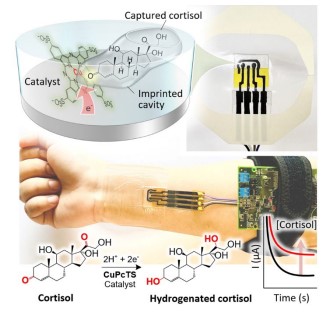An extremely sensitive, stable, and specific biosensor using electrocatalytic molecularly imprinted polymers and no enzymes or reagents
Background
Electrochemical biosensors can successfully detect and quantify diverse biological samples including macromolecules, whole viruses, and cells. Due to their fabrication methods electrochemical biosensors can be mass produced inexpensively. However, many electrochemical biosensors do not have a specific binding mechanism resulting in non-specific binding of analytes. To overcome this issue, the general solution has been to coat electrode surfaces in organic layers such as self-assembled monolayers or polymer films. These biological binding sites often suffer from thermal instability and are subject to fouling. Additionally, the enzymes and antibodies are generally expensive and difficult to handle. Molecularly imprinted polymers (MIPs) coated onto working electrode surfaces can enhance the specificity of electrochemical biosensors without the need to immobilize biologically active molecules. Yet, challenges remain in improving the durability and stability of MIP solutions.
Technology Description
This electrochemical biosensor is designed for rapid tracking of chemical compounds in the human body, such as cortisol. The sensor is based upon synthetic mimicking of an enzyme that utilizes electrocatalytic molecularly imprinted polymer (EC-MIP) to enable label-free, reagent less, sensitive, and selective electrochemical detection of analytes. In one example for cortisol detection, the sensor utilizes EC-MIP to recognize cortisol and catalyze hydrogenation for amperometric measurement. An enzyme substitute is embedded in the EC-MIP, mimicking the enzyme's active center with similar efficiency. The cortisol sensor yielded a 128 pM detection limit and a wide dynamic range from 100 pM to 1 µM. In general, this EC-MIP sensor can have superior selectivity against structurally similar compounds and common metabolites. The simple sensing method eliminates the need for an enzyme or antibody, significantly improving the stability and robustness. The new EC-MIP sensor could lead to a practical approach for next-generation continuous metabolite sensing for personal health monitoring.

Features & Benefits
- Very low detection limit and wide detection range
- High stability
- Label-free, reagent less, sensitive, and selective detection
- Rapid response time
Applications
- Faster and easier detection of molecular markers of stress and/or poor health conditions
- Integration into wearable technology for continuous health monitoring
- Complementary sensors for detection of several compounds of interest
Status
Provisional patent application filed.